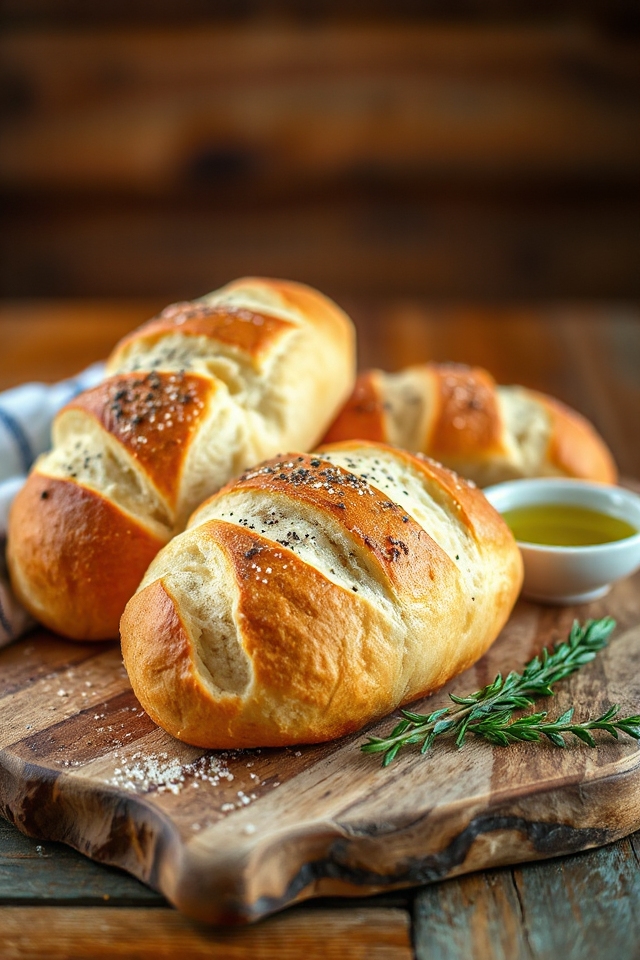Why You’ll Love This Mock Sourdough French Bread Recipe
If you’ve ever craved the tangy flavor of sourdough but didn’t have the time or patience to cultivate a starter, you’ll love this Mock Sourdough French Bread recipe.
It’s quick and simple, letting you enjoy that sourdough taste without the long wait. The yogurt gives it a delightful tang, while the texture stays soft and airy.
Plus, you can whip this up in just a couple of hours. Whether you’re serving it with dinner or slathering it with butter, this bread will impress your family and friends.
Trust me, once you try it, you’ll be hooked!
Ingredients of Mock Sourdough French Bread
When it comes to making delicious Mock Sourdough French Bread, the right ingredients are key. This recipe isn’t only straightforward but also brings together flavors and textures that will make your taste buds dance.
With a mix of yogurt, spices, and flour, you’ll be on your way to creating a loaf that’s sure to impress at your next meal. Let’s take a closer look at what you’ll need to whip up this delightful bread.
Ingredients:
- 2 (8 ounce) cartons plain yogurt (non-fat works great!)
- 2 packages active dry yeast
- 1 package expired dry yeast (for flavor)
- 1/4 cup warm water (110-115 degrees F)
- 1 tablespoon sugar
- 2 teaspoons salt
- 2 tablespoons extra virgin olive oil
- 4-5 cups unbleached flour
- Cold water (for brushing)
- Fresh coarse ground black pepper (optional, for topping)
Now, before you rush off to the kitchen, let’s chat a bit about these ingredients.
First off, using yogurt is a game changer because it not only adds that delightful tang we associate with sourdough but also keeps the bread moist and tender.
Don’t stress if you can’t find unbleached flour; regular all-purpose flour works just fine.
And that expired yeast? It may sound odd, but it adds a depth of flavor that’s hard to replicate.
Just remember, it’s not about the fancy ingredients, but the love you put into making this bread.
How to Make Mock Sourdough French Bread

Making Mock Sourdough French Bread is a delightful journey that starts with some pretty simple steps. First, let’s talk about that 2 (8 ounce) cartons of plain yogurt. You’ll want to heat it up until it’s lukewarm—think cozy bath temperature, around 110 degrees F.
While that’s warming, take 1/4 cup of warm water (also at that perfect temperature) and sprinkle 2 packages of active dry yeast along with 1 package of expired dry yeast into it. Stir it gently and let it sit for about 5 to 10 minutes. This little yeast party is vital because it gets those bubbles going, which will help your bread rise and be all fluffy.
Once your yeast is frothy and excited, mix in the warmed yogurt, 1 tablespoon of sugar, 2 teaspoons of salt, and 2 tablespoons of extra virgin olive oil into a large mixing bowl.
Now, here comes the fun part—sift in 2 cups of unbleached flour and beat the mixture until it’s smooth. It’s like a workout for your arms, really. As you mix, add enough additional flour until the dough is easy to handle. You might find yourself covered in flour, and that’s totally normal.
Knead the dough for about 5 minutes until it’s smooth and elastic. Just think of it as a mini massage for your bread. Once it’s ready, pop it into an oiled bowl, cover it up, and let it rise in a warm space until it doubles in size.
After the dough has risen, it’s time to punch it down—yes, that’s right, punch it! This is both satisfying and necessary.
Divide the dough into 8 equal parts, knead each one briefly, and flatten them into a rectangle. Roll them up tight like a burrito, pinching the edges to seal. Place them seam side down on greased cookie sheets dusted with cornmeal, and let them rise again until they puff up—about 30-40 minutes.
Now, before you pop those beauties in the oven, preheat it to 375 degrees F. Brush the tops with cold water, make those cute diagonal cuts, and sprinkle with fresh coarse ground black pepper if you’re feeling fancy.
Bake them until they sound hollow when tapped or reach 190 degrees F inside. This may take about 35 minutes. You’ll be amazed at how your kitchen smells like a bakery.
Once they’re done, cool them on a wire rack before wrapping. Just remember, if you can resist, let them cool completely—otherwise, you might end up with a loaf that’s too hot to handle. Happy baking!
Mock Sourdough French Bread Substitutions & Variations
While my Mock Sourdough French Bread recipe is already a winner, there are plenty of substitutions and variations you can try to make it uniquely yours.
For a richer flavor, swap some of the yogurt for buttermilk or add a splash of vinegar. If you’re after a whole-grain twist, use half whole wheat flour.
Want herbs? Toss in fresh rosemary or thyme for a fragrant touch. For a cheesy crust, sprinkle grated Parmesan on top before baking.
Feel free to experiment with different spices, like garlic powder or onion powder, to elevate your bread experience. Let your creativity shine!
Additional Tips & Notes
To guarantee your Mock Sourdough French Bread turns out perfectly, I recommend paying close attention to your ingredient temperatures.
Using lukewarm yogurt and water activates the yeast effectively, ensuring a good rise. Don’t skip the brushing of cold water on the loaves; it helps create a beautiful crust.
If you want to add flavors, consider herbs or garlic powder in the dough. Remember to let the bread cool completely on a wire rack before wrapping it; this prevents sogginess.
Finally, if you freeze any loaves, reheat them in the oven to bring back that fresh, crispy texture.
Happy baking!
